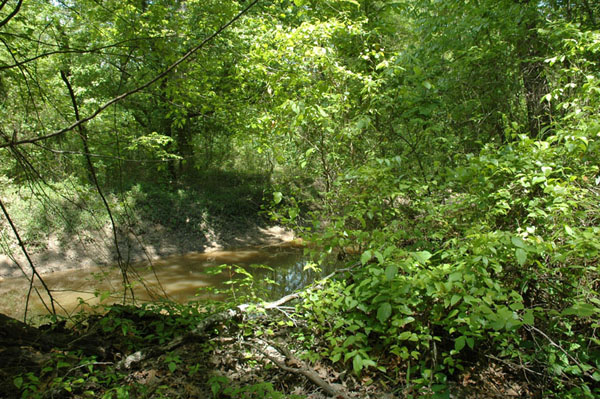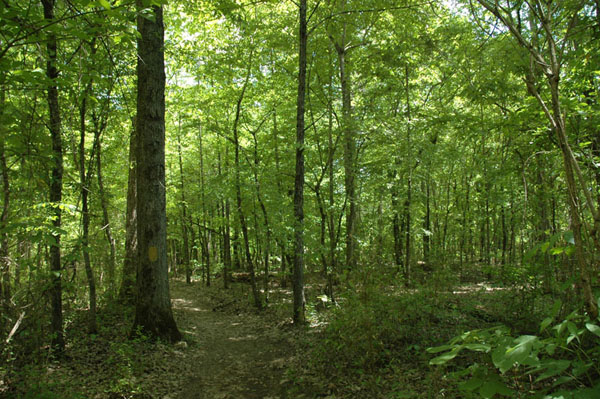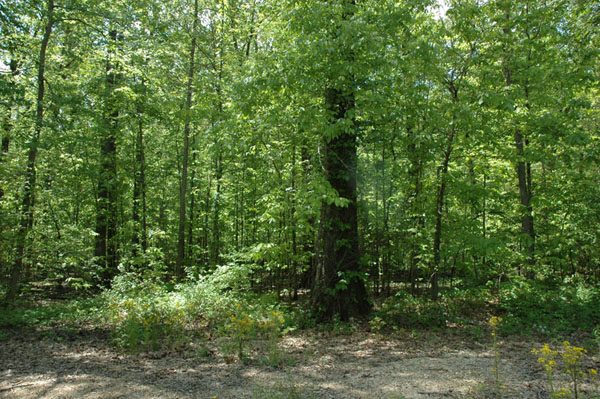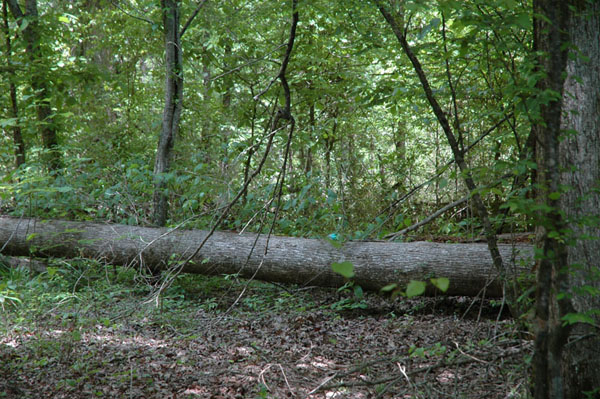Ants in Bottomland Hardwood Forests of Noxubee National Wildlife Refuge, Mississippi
Joe A. MacGown and JoVonn G. Hill
Click links to view ants in the primary habitat types at the Noxubee National Wildlife Refuge.
[Noxubee Ants-all habitats] [pine forests] [pine/hardwood forests] [bottomland hardwood forests] [upland hardwood forests] [fields, grasslands, & other open areas] [disturbed wooded areas]
A recent project was undertaken by the MEM to survey the Noxubee National Wildlife Refuge in Oktibbeha, Noxubee, and Winston Counties for ants. The refuge owns approximately 48,000 acres, which can be separated into three primary habitats: forests, fields and grasslands, and wetlands. By far, forests form the majority of the refuge and cover about 45,000 acres (about 93%). The forests can be further divided into four major types including pine (23,619 acres), mixed pine/hardwood (2,851 acres), bottomland hardwood (15,453 acres), and upland hardwood (3,263 acres). In this study we examined six terrestrial habitat types to determine species compositions for each habitat. Habitat types for this study included pine forests (both mature and young forests, and recently burned or unburned); bottomland hardwood forests (including cypress dominanted areas); upland hardwood forests; mixed pine/hardwood forests (including one area intermixed with cedar); open habitats including fields, grasslands, roadsides, and a sand pit; and disturbed, open mixed forests located near buildings and picnic areas. The latter disturbed sites were included because of their likelihood of being ideal habitats for various exotic species. In addition to the ants collected during this survey, the total list of species from the refuge includes earlier records of ants collected by the Mississippi Entomological Museum (MEM). Collecting methods included baiting, beating and sweeping vegetation, litter sampling, and visually searching for ants and their colonies. Our collections have revealed a diverse fauna, and we have collected 98 species (species list) at the refuge.
Bottomland hardwood forests are basically floodplain forests that have developed adjacent to and follow rivers. If the topography of the area is flat enough, as is common in the Southeast, then these forests may be extensive. Approximately 15,000 acres of bottomland hardwood forests are found at the Noxubee NWR with bald cypress and water tupelo being found in the wettest areas that are continuously flooded, and variety of other tree species such as cherry bark, swamp, overcup, water and willow oaks, beech, box elder, sweetgum, river birch, yellow-poplar, red maple, elm, and sycamore in those areas that are flooded less frequently or rarely. Life for ants living in these forests can be challenging. Obviously, in the areas that are consistently flooded, ants cannot live in soil or leaf litter, so they are relegated to living arboreally in live or dead trees and vines. In fact, some species, such as Crematogaster vermiculata, are only known to occur in these flooded forests. However, many ant species do nest in soil in litter and manage to survive in those areas that are less frequently flooded, despite being periodically inundated by water. But, more typically, ant species in these forests nest in rotting wood, trees, vines, or other plant material, or manage to find high spots to build their nests. Perhaps somewhat counterintuitively, ant diversity is actually quite high in the bottomland forests, and it was in this habitat that we have found the highest number of species. This is most likely due to the high level of plant diversity and vegetative "structure", such as rotting logs, standing dead trees, and vines, which provide suitable nesting sites for many species of ants. During this study we found 60 species in bottomland hardwood habitat, making it the most diverse habitat for ants at the refuge (species list below).
 |
 |
 |
 |
Bottomland Hardwood Forest habitat |
|
Ants from Bottomland Hardwood forests of the Noxubee National Wildlife Refuge
(Species are arranged alphabetically by genus)
Aphaenogaster carolinensis Wheeler
Aphaenogaster fulva Roger
Aphaenogaster lamellidens Mayr
Aphaenogaster mariae Forel
Brachymyrmex depilis Emery
Brachymyrmex sp.-03 ?? (apparently different from B. depilis)
Camponotus caryae (Fitch) (pest?)
Camponotus castaneus (Latreille) (pest)
Camponotus chromaiodes Bolton (pest)
Camponotus decipiens Emery (pest)
Camponotus nearcticus Emery
Camponotus pennsylvanicus (DeGeer) (pest)
Camponotus snellingi Bolton (pest)
Camponotus subbarbatus Emery (pest)
Colobopsis impressa Roger
Colobopsis mississippiensis (Smith)
Crematogaster ashmeadi Mayr (pest)
Crematogaster lineolata (Say) (pest)
Crematogaster pilosa Emery (pest)
Crematogaster vermiculata Emery
Cryptopone gilva(Roger)
Discothyrea testacea Roger
Formica pallidefulva Latreille
Hypoponera opaciceps (Mayr) (introduced)
Hypoponera opacior (Forel)
Monomorium minimum (Buckley) (pest)
Myrmecina americana Emery
Myrmica punctiventris Roger
Lasius aphidicola (Walsh)
Lasius americanus Emery
Nylanderia faisonensis (Forel)
Pheidole dentata Mayr (pest?)
Pheidole dentigula Smith
Ponera exotica Smith
Ponera pennsylvanica Buckley
Prenolepis imparis (Say)
Proceratium pergandei (Emery)
Proceratium silaceum Roger
Pseudomyrmex ejectus (Smith) (pest?)
Pseudomyrmex pallidus (Smith) (pest?)
Solenopsis carolinensis Forel ?? [appears to be this species]
Solenopsis invicta x richteri (introduced, pest) [in openings, along trails, & on roadsides]
Stigmatomma pallipes (Haldeman)
Strumigenys abdita Wesson & Wesson
Strumigenys angulata Smith
Strumigenys clypeata Roger
Strumigenys dietrichi Smith
Strumigenys louisianae Roger
Strumigenys ohioensis Kennedy & Schramm
Strumigenys ornata Mayr
Strumigenys pergandei Emery
Strumigenys pulchella Emery
Strumigenys rostrata Emery
Strumigenys talpa Weber
Tapinoma sessile (Say) (pest)
Temnothorax curvispinosus (Mayr)
Temnothorax longispinosus (Roger)
Temnothorax pergandei (Emery)
Temnothorax schaumii (Roger)
Links
MacGown, J. A., J. G. Hill, T. L. Schiefer, and R. L. Brown. 2012. Ant diversity and habitat associations at the Noxubee National Wildlife Refuge in Mississippi. Mississippi Agricultural and Forestry Experiment Station Technical Bulletin 1197. [pdf]
Landmarks article about the Noxubee Study [pdf]
Noxubee National Wildlife Refuge [http://www.fws.gov/noxubee/]


